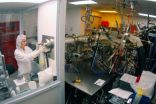(Press-News.org) The wispy arms of the Tarantula Nebula were originally thought to resemble spindly spider legs, giving the nebula its unusual name. The part of the nebula visible in this image from Hubble's Advanced Camera for Surveys is criss-crossed with tendrils of dust and gas churned up by recent supernovae. These supernova remnants include NGC 2060, visible above and to the left of the centre of this image, which contains the brightest known pulsar.
The tarantula's bite goes beyond NGC 2060. Near the edge of the nebula, outside the frame, below and to the right, lie the remains of supernova SN 1987a, the closest supernova to Earth to be observed since the invention of telescopes in the 17th century. Hubble and other telescopes have been returning to spy on this stellar explosion regularly since it blew up in 1987, and each subsequent visit shows an expanding shockwave lighting up the gas around the star, creating a pearl necklace of glowing pockets of gas around the remains of the star. SN 1987a is visible in wide field images of the nebula, such as that taken by the MPG/ESO 2.2-metre telescope.
Together with dying stars, the Tarantula Nebula is packed with young stars which have recently formed from the nebula's supply of hydrogen gas. These toddler-stars shine forth with intense ultraviolet light that ionises the gas, making it light up red. The light is so intense that although around 170 000 light-years distant, and outside the Milky Way, the Tarantula Nebula is nevertheless visible without a telescope on a dark night to Earth-bound observers. This nebula might be far away, but it is the most luminous example of its type that astronomers have observed in the local Universe.
A compact and extremely bright star cluster called RMC 136 (http://www.spacetelescope.org/images/opo0932a/) lies above and to the left of this field of view, providing much of the radiation that powers the multi-coloured glow. Until recently, astronomers debated whether the source of the intense light was a tightly bound cluster of stars, or perhaps an unknown type of super-star thousands of times bigger than the Sun. It is only in the last 20 years, with the fine detail revealed by Hubble and the latest generation of ground-based telescopes, that astronomers have been able to conclusively prove that it is, indeed, a star cluster.
But even if the Tarantula Nebula doesn't contain this hypothetical super-star, it still hosts some extreme phenomena, making it a popular target for telescopes. Within the bright star cluster lies star RMC 136a1, which was recently found to be the heaviest ever discovered, at around 300 times the mass of the Sun at its birth (http://www.eso.org/public/news/eso1030/). This heavyweight is challenging astronomers' theories of star formation, smashing through the upper limit they thought existed on star mass.
INFORMATION:
Notes
The Hubble Space Telescope is a project of international cooperation between ESA and NASA.
Image credit: NASA, ESA
Links
- Images of Hubble: http://www.spacetelescope.org/images/archive/category/spacecraft/
- http://en.wikipedia.org/wiki/Tarantula_Nebula
- http://www.naic.edu/~gibson/30dor/
- http://coolcosmos.ipac.caltech.edu/cosmic_classroom/multiwavelength_astronomy/multiwavelength_museum/30dor.html
- http://apod.nasa.gov/apod/ap081111.html
- http://www.eso.org/public/news/eso1030/
- http://en.wikipedia.org/wiki/R136a1
- http://en.wikipedia.org/wiki/R136
- http://seds.org/messier/xtra/ngc/lmc_sn1987A.html
- http://www.eso.org/public/news/eso1033/
Contacts
Oli Usher
Hubble/ESA
Garching bei München, Germany
Tel: +49-89-3200-6855
Email: ousher@eso.org
Arachnophobes beware: Hubble snaps close-up of the Tarantula
2011-03-16
ELSE PRESS RELEASES FROM THIS DATE:
Risks of Breast Augmentation
2011-03-16
It is important for you to know the possible risks associated with breast augmentation before undergoing the procedure. With the placement of a foreign object into your body, breast augmentation carries an additional set of possible complications not found in other surgical procedures.
Surgical Risks
Just like any other surgical procedure, breast augmentation carries risk factors that pose an unlikely but serious threat to your health. Some serious surgical complications include:
- Allergic reaction to anesthesia - general anesthesia carries rare but potentially ...
Social class makes no difference to water contamination risk
2011-03-16
Wealthy, well educated people who choose to drink bottled water rather than water from public supplies may be no less exposed to potentially cancer-causing water contaminants, according to new research published in BioMed Central's open access journal Environmental Health.
As part of the EPICURO national bladder cancer study, researchers from all over Spain quizzed 1,270 individuals about their water use and consumption in an effort to discover whether social class has any bearing on exposure to common water disinfection byproducts. High levels of trihalomethanes (THM), ...
Teen Cell Phone Use and Car Accidents
2011-03-16
Cell phone use is on the rise. The incidence of driving and talking or texting is too. Distracted driving and youthful drivers are two factors that have always impacted accident statistics. The combination of these two factors with the advent of the cell phone has added to an increasingly dangerous trend. Many states have already enacted legislation that place additional restrictions on youthful drivers and cell phone use. There are no such laws in the state of Georgia so even with the number of teen drivers in the greater Atlanta area no restrictions exist.
The statistics ...
Prozac reorganizes brain plasticity
2011-03-16
Selective serotonin reuptake inhibitors (SSRI) such as Prozac are regularly used to treat severe anxiety and depression. They work by immediately increasing the amount of serotonin in the brain and by causing long term changes in brain function. However it can take weeks of treatment before a patient feels any effect and both beneficial effects and side effects can persist after treatment is stopped. New research published by BioMed Central's open access journal Molecular Brain investigates physiological changes within the brain that may be caused by SSRI treatment.
The ...
Miniature lasers could help launch new age of the Internet
2011-03-16
A new laser device created at the University of Central Florida could make high-speed computing faster and more reliable, opening the door to a new age of the Internet.
Professor Dennis Deppe's miniature laser diode emits more intense light than those currently used. The light emits at a single wavelength, making it ideal for use in compact disc players, laser pointers and optical mice for computers, in addition to high-speed data transmission.
Until now, the biggest challenge has been the failure rate of these tiny devices. They don't work very well when they face ...
New Rule Designed to Help Keep Occupants Inside During a Vehicle Rollover
2011-03-16
U.S. Department of Transportation has issued a new rule aimed at preventing occupant ejections in passenger vehicles.
The rule, issued by the National Highway Traffic Safety Administration (NHTSA), is designed to help reduce the number of people partially or completely ejected through side windows during rollover crashes, and will be phased in from 2013 to 2018.
New side curtain airbags will be used to contain passengers inside the vehicle, though the standards require the airbag to prevent ejection even if the widow is open.
The agency has also upgraded the roof ...
Describing humor with an equation
2011-03-16
A new theory suggests an equation for identifying the cause and level of our responses to any humorous stimuli: h = m x s
The theory argues that human beings are more reliant for their behavioural instruction on culturally inherited information than any other species, and that the accuracy of that information is therefore of unparalleled importance. Yet the individual is exposed to the continual threats of error and deception, which can seriously affect their chances of survival and success.
To compensate, humour rewards us for seeing through misinformation that has ...
Inflammation behind heart valve disease
2011-03-16
Research from Karolinska Institutet in Sweden shows, that a specific inflammatory factor may be important in the development of the heart valve disease aortic stenosis. The results suggest that anti-inflammatory medication could be a possible new treatment.
Aortic stenosis is the most common heart valve disease, which is caused by calcium deposits and a narrowing of the aortic valve. This is typically seen in the elderly, but can also be caused by a congenital defect. Aortic stenosis is currently treated by surgical replacement of the diseased valve, but research is on-going ...
MyPhillyLawyer Releases Birth Injury Website
2011-03-16
The Philadelphia law firm of Silvers, Langsam & Weitzman, P.C., known throughout the area as MyPhillyLawyer, is launching a brand new informational birth injury website. The website, www.birthinjuryinfo.org, will be a resource for families and parents of babies and children who suffered a birth injury as a result of negligent care during pregnancy or childbirth.
The birth injury lawyers at MyPhillyLawyer are committed to providing relevant and up-to-date information about birth injuries, such as Erb's Palsy, Cerebral Palsy, brain injuries and other serious and life-threatening ...
Single gene defect causes brain tumor
2011-03-16
Pilocytic astrocytoma, the most common brain tumor in children, is usually slow-growing and benign. However, surgeons often cannot completely remove the diffusely growing tumor. This means that patients need further treatment in order to destroy remaining tumor tissue. Chemotherapy or radiation therapy can lead to severe side-effects and have only little effect on these slowly growing tumors. Affected children therefore urgently need new, targeted therapies.
A typical genetic defect in these brain tumors is already known: "From our own research we know that there is ...

